5 key considerations for cloud backup and disaster recovery


Connecting state and local government leaders
Integrating the cloud into an agency’s day-to-day backup and recovery operation is not a one-size-fits-all solution.
Modern day, data backup and recovery solutions have moved from traditional tape and hardware-dependent solutions to cloud-based solutions that offer agencies a far more nimble means of recovering critical data in the event of any disruption. Although the cloud is becoming more accepted by the public and private sector, there remain concerns about moving data to the cloud and relying on the cloud to continue workflow without disruption should a primary server fail, for example.
Government agencies, charged with responsibility for data privacy and protection, must feel confident any cloud-based disaster recovery solution they put into place will add efficiency and more reliable storage and retrieval. IT managers may also be looking at a combination of data backup and recovery solutions, for example, that maintain some data on site and move other data direct to the cloud. As we see with the adoption of hybrid cloud solutions, integrating the cloud into an agency’s day-to-day backup and recovery operation is not a one-size-fits-all solution.
In evaluating a cloud backup and recovery platform, it’s important to first think through your IT goals. Have you had instances recently in which data was not recoverable quickly enough and caused service issues to your agency’s customers? Are you anticipating a new set of compliance-related regulations that will inevitably require more backup and more timely access in the case of a disruptive event? Are you setting new IT goals for data recovery and restore such as a more effective response to any disruption and the ability to get the data you need -- from the cloud -- at a speed that meets your performance standards?
The omnipresent budget concern is also a factor. The cloud’s role in moving operations from capital expenditures to operational expenditures is a hot subject these days. That being said, IT managers need to make sure adding, or further integrating cloud recovery, works within their budget parameters and helps fulfill performance goals.
Consider these factors in moving to an advanced cloud-based recovery solution:
1. Cloud cost analysis. While in an ideal world all data may be stored in the cloud, budget decisions often necessitate making a judgment call on the most critical data. When pursuing integrated cloud recovery, determine what technology fits the budget. Pricing considerations should include the backup and recovery of files, databases, server images for both physical and virtual servers with no limitation on the number of servers and endpoints, auditing and 24 x 7 U.S.-based engineer-level support. When talking about operational expenditures, scalability related to pricing should be considered. If your agency becomes responsible for new services with an accompanying influx of new data, what will be the additional costs?
2. Determining desired backup speed. As datasets continue to increase in size, the optimum solution is one that can handle capacity as well as provide the backup speed required. Speed is important to meet the backup window and to recover data quickly. A high-speed data transfer rate (advanced technology can transfer up to 5TB of data in 12 hours) gives agencies a much better shot ensuring systems and applications are backed up within a specified window with minimal disruption.
3. Transitioning from hardware-focused approach. According to analyst firm IDC, the average cost of downtime is about $100,000 per hour. Even more surprising, most organizations experience 10 to 20 hours of unplanned downtime every year -- and that’s without any natural disaster taking place. Legacy backup and recovery systems have relied on tape backup and hardware that is neither cost effective nor able to efficiently withstand the onslaught of data that exists in agencies today. These legacy systems are also ill-equipped to provide prompt recovery from natural disasters such as hurricanes, to unplanned downtime as the result of system failure.
The hardware approach is costly because an agency may have to wait days for an appliance replacement. Moving to a direct-to-cloud approach eliminates the need to wait for a hardware appliance and accelerates data recovery. This enables an agency to recover data -- in the cloud -- without having to wait for an appliance replacement when a disaster event occurs.
4. Setting recovery time objective. When developing a cloud-based backup and recovery platform, consider how long your agency can go without having access to data. Setting a recovery time objective provides the parameters IT managers need to work with in providing backup and restore. This can be as long as a day or as short as an hour.
5. Providing an efficient user experience. For an IT pro, an appliance-free, cloud recovery solution should be manageable from any agency location. Managers should be able to log in via the web and commence a restore. More advanced solutions enable downloading files without recovering an entire server image first. However, ease of use is only one standard in evaluating cloud recovery options. There should also be the expectation of 24 x 7 technical support, with a live person. Any solution should also be compliant with the Statement on Standards for Attestation Engagements, No. 16, the Health Insurance Portability and Accountability Act and International Traffic in Arms Regulations.
These five issues described – cost factors, desired backup speed, the advantages of eliminating hardware appliances, setting recovery time objectives and user flexibility in recovering files -- are a good beginning in evaluating moving to a direct-to-cloud platform.
Clearly this technology sector will continue to make advances, driven by the growth of data and the need to provide fast backup to protect critical files. But the future of fast, reliable data recovery lies in the cloud as tape and hardware have already proven to be costly and inefficient.




